2021 LEXUS LS500 tire pressure
[x] Cancel search: tire pressurePage 464 of 520
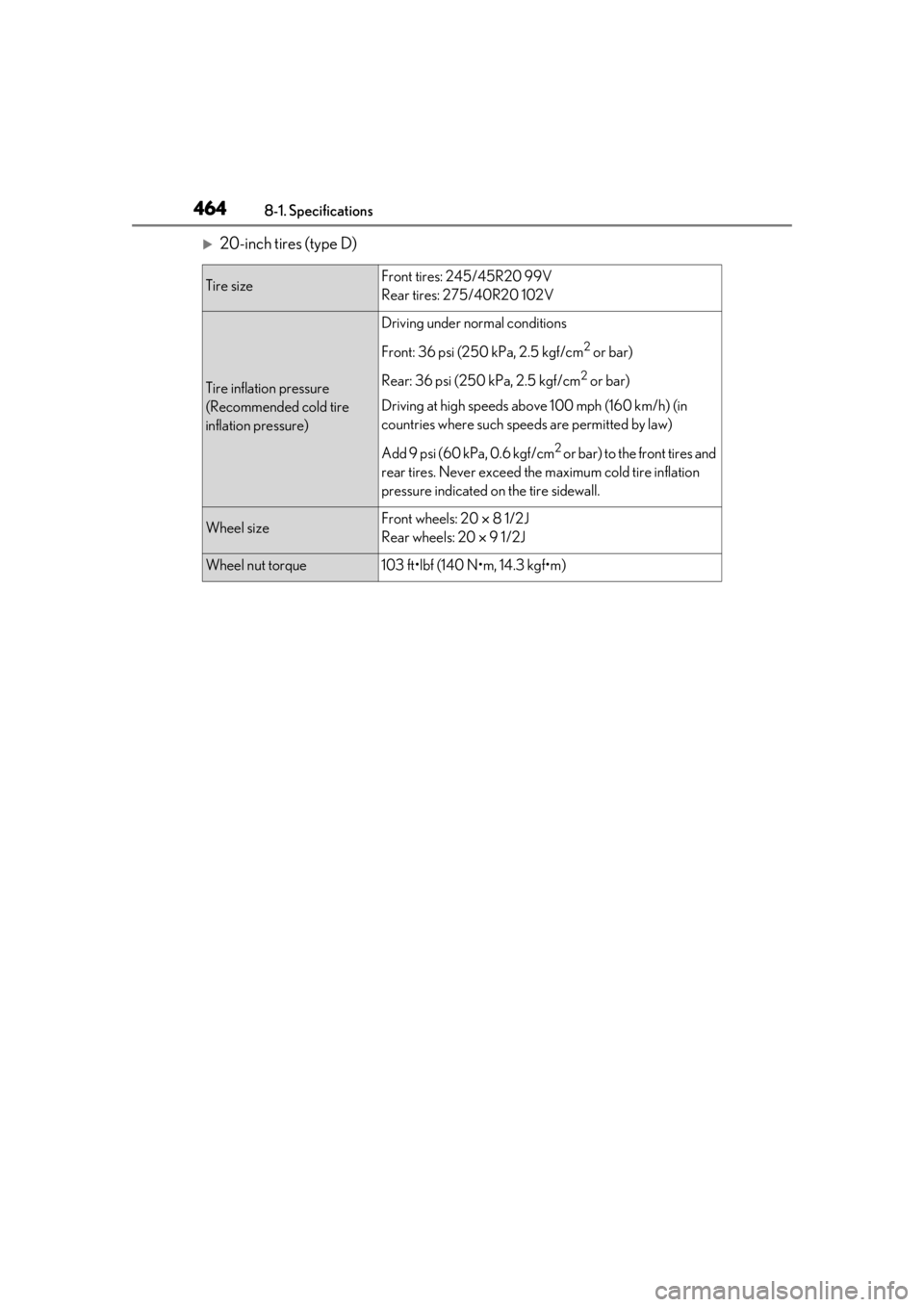
4648-1. Specifications
20-inch tires (type D)
Tire sizeFront tires: 245/45R20 99V
Rear tires: 275/40R20 102V
Tire inflation pressure
(Recommended cold tire
inflation pressure)
Driving under normal conditions
Front: 36 psi (250 kPa, 2.5 kgf/cm
2 or bar)
Rear: 36 psi (250 kPa, 2.5 kgf/cm
2 or bar)
Driving at high speeds above 100 mph (160 km/h) (in
countries where such speeds are permitted by law)
Add 9 psi (60 kPa, 0.6 kgf/cm
2 or bar) to the front tires and
rear tires. Never exceed the maximum cold tire inflation
pressure indicated on the tire sidewall.
Wheel sizeFront wheels: 20 8 1/2J
Rear wheels: 20 9 1/2J
Wheel nut torque103 ft•lbf (140 N•m, 14.3 kgf•m)
Page 467 of 520
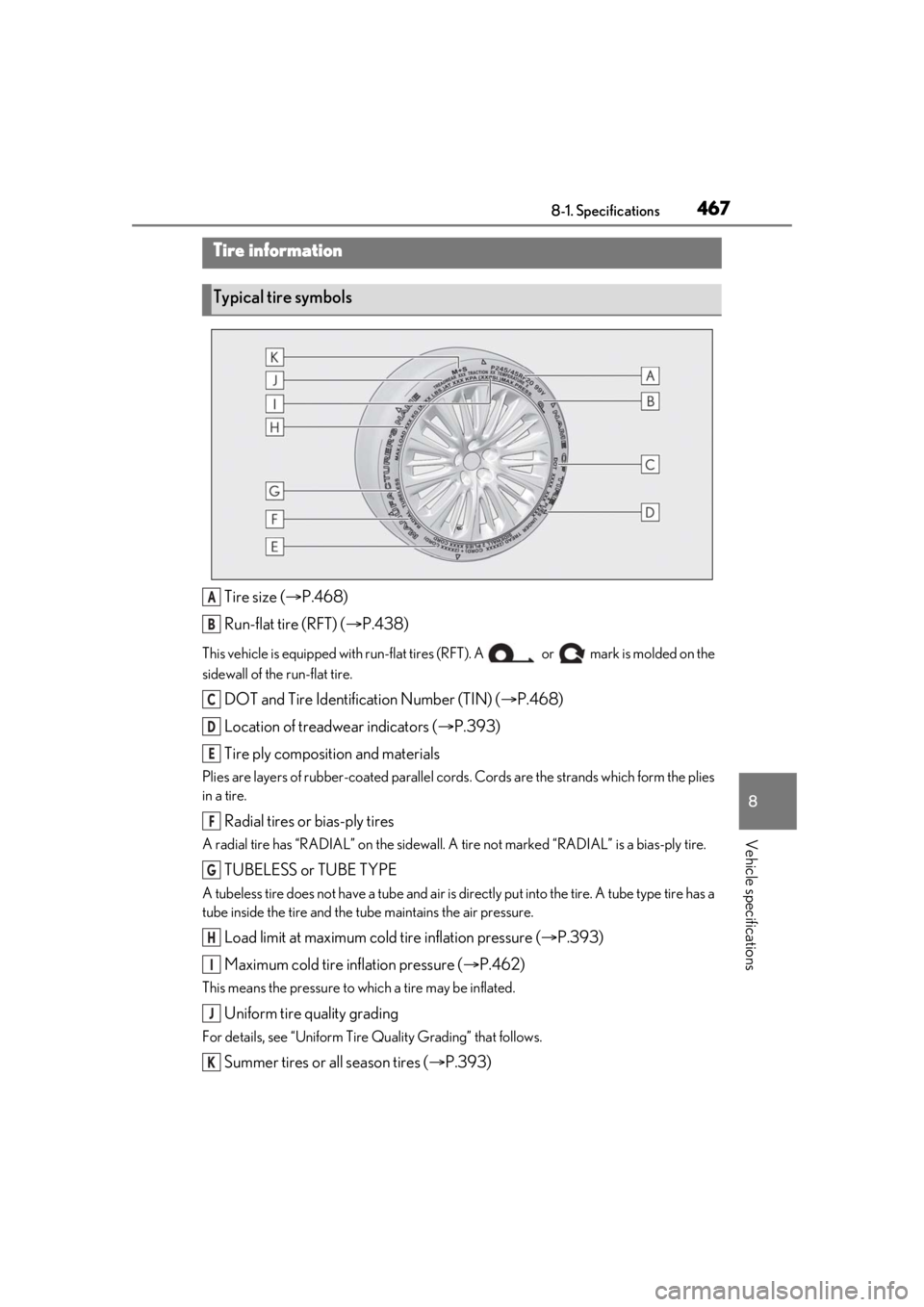
4678-1. Specifications
8
Vehicle specifications
Tire size (P.468)
Run-flat tire (RFT) ( P.438)
This vehicle is equipped with run-flat tires (RFT). A or mark is molded on the
sidewall of the run-flat tire.
DOT and Tire Identification Number (TIN) ( P.468)
Location of treadwear indicators ( P.393)
Tire ply composition and materials
Plies are layers of rubber-coated parallel cords. Cords are the strands which form the plies
in a tire.
Radial tires or bias-ply tires
A radial tire has “RADIAL” on the sidewall. A tire not marked “RADIAL” is a bias-ply tire.
TUBELESS or TUBE TYPE
A tubeless tire does not have a tube and air is directly put into the tire. A tube type tire has a
tube inside the tire and the tube maintains the air pressure.
Load limit at maximum cold tire inflation pressure ( P.393)
Maximum cold tire inflation pressure ( P.462)
This means the pressure to which a tire may be inflated.
Uniform tire quality grading
For details, see “Uniform Tire Quality Grading” that follows.
Summer tires or all season tires ( P.393)
Tire information
Typical tire symbols
A
B
C
D
E
F
G
H
I
J
K
Page 470 of 520
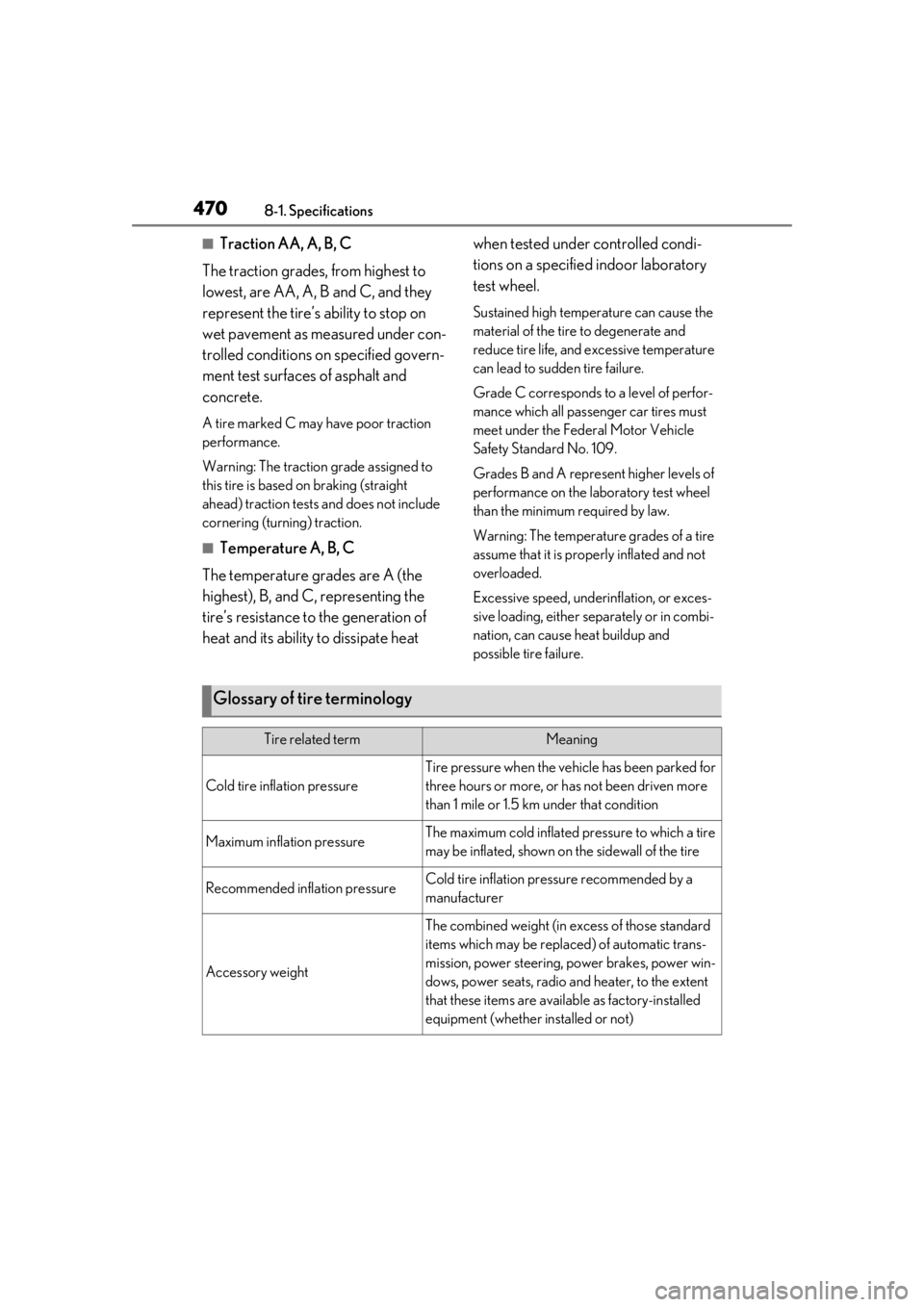
4708-1. Specifications
■Traction AA, A, B, C
The traction grades, from highest to
lowest, are AA, A, B and C, and they
represent the tire’s ability to stop on
wet pavement as measured under con-
trolled conditions on specified govern-
ment test surfaces of asphalt and
concrete.
A tire marked C may have poor traction
performance.
Warning: The traction grade assigned to
this tire is based on braking (straight
ahead) traction tests and does not include
cornering (turning) traction.
■Temperature A, B, C
The temperature grades are A (the
highest), B, and C, representing the
tire’s resistance to the generation of
heat and its ability to dissipate heat when tested under controlled condi-
tions on a specified indoor laboratory
test wheel.
Sustained high temperature can cause the
material of the tire to degenerate and
reduce tire life, and excessive temperature
can lead to sudd
en tire failure.
Grade C corresponds to a level of perfor-
mance which all passenger car tires must
meet under the Fede ral Motor Vehicle
Safety Standard No. 109.
Grades B and A represent higher levels of
performance on the laboratory test wheel
than the minimum required by law.
Warning: The temperature grades of a tire
assume that it is properly inflated and not
overloaded.
Excessive speed, unde rinflation, or exces-
sive loading, either separately or in combi-
nation, can cause heat buildup and
possible tire failure.
Glossary of tire terminology
Tire related termMeaning
Cold tire inflation pressure
Tire pressure when the vehicle has been parked for
three hours or more, or has not been driven more
than 1 mile or 1.5 km under that condition
Maximum inflation pressureThe maximum cold inflated pressure to which a tire
may be inflated, shown on the sidewall of the tire
Recommended inflation pressureCold tire inflation pressure recommended by a
manufacturer
Accessory weight
The combined weight (in excess of those standard
items which may be replaced) of automatic trans-
mission, power steering, power brakes, power win-
dows, power seats, radio and heater, to the extent
that these items are available as factory-installed
equipment (whether installed or not)
Page 472 of 520
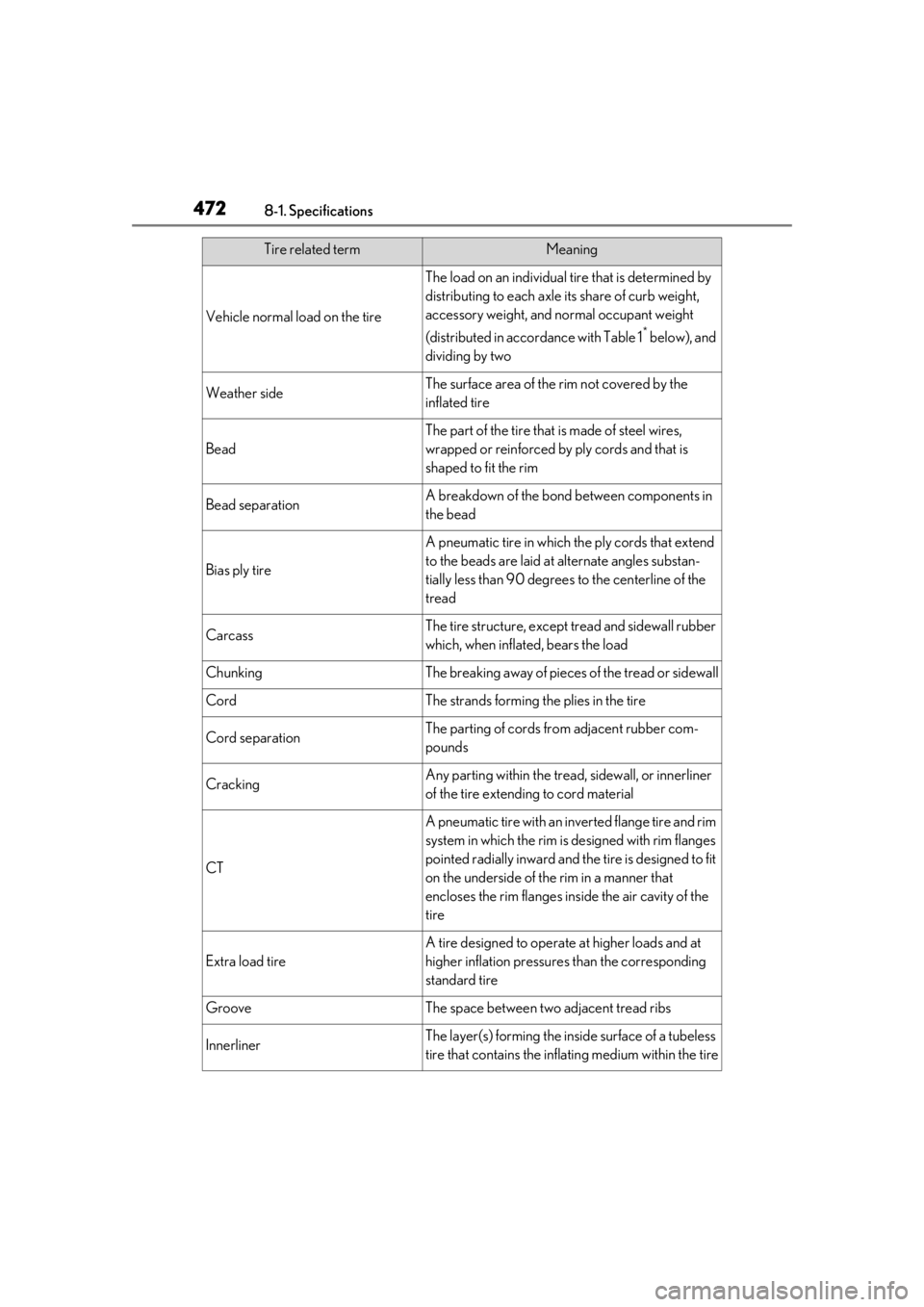
4728-1. Specifications
Vehicle normal load on the tire
The load on an individual tire that is determined by
distributing to each axle its share of curb weight,
accessory weight, and normal occupant weight
(distributed in accor dance with Table 1
* below), and
dividing by two
Weather sideThe surface area of the rim not covered by the
inflated tire
Bead
The part of the tire that is made of steel wires,
wrapped or reinforced by ply cords and that is
shaped to fit the rim
Bead separationA breakdown of the bond between components in
the bead
Bias ply tire
A pneumatic tire in which the ply cords that extend
to the beads are laid at alternate angles substan-
tially less than 90 degrees to the centerline of the
tread
CarcassThe tire structure, except tread and sidewall rubber
which, when inflated, bears the load
ChunkingThe breaking away of pieces of the tread or sidewall
CordThe strands forming the plies in the tire
Cord separationThe parting of cords from adjacent rubber com-
pounds
CrackingAny parting within the tread, sidewall, or innerliner
of the tire extending to cord material
CT
A pneumatic tire with an inverted flange tire and rim
system in which the rim is designed with rim flanges
pointed radially inward and the tire is designed to fit
on the underside of the rim in a manner that
encloses the rim flanges inside the air cavity of the
tire
Extra load tire
A tire designed to operat e at higher loads and at
higher inflation pressures than the corresponding
standard tire
GrooveThe space between two adjacent tread ribs
InnerlinerThe layer(s) forming the in side surface of a tubeless
tire that contains the inflating medium within the tire
Tire related termMeaning
Page 473 of 520

4738-1. Specifications
8
Vehicle specifications
Innerliner separationThe parting of the innerliner from cord material in
the carcass
Intended outboard sidewall
(a) The sidewall that contains a whitewall, bears
white lettering, or bear s manufacturer, brand,
and/or model name molding that is higher or
deeper than the same molding on the other sidewall
of the tire, or
(b) The outward facing sidewall of an asymmetrical
tire that has a particular side that must always face
outward when mounted on a vehicle
Light truck (LT) tire
A tire designated by its manufacturer as primarily
intended for use on lightwe ight trucks or multipur-
pose passenger vehicles
Load ratingThe maximum load that a tire is rated to carry for a
given inflation pressure
Maximum load ratingThe load rating for a tire at the maximum permissi-
ble inflation pressure for that tire
Maximum permissible inflation pres-
sureThe maximum cold inflation pressure to which a tire
may be inflated
Measuring rimThe rim on which a tire is fitted for physical dimen-
sion requirements
Open spliceAny parting at any junction of tread, sidewall, or
innerliner that extends to cord material
Outer diameterThe overall diameter of an inflated new tire
Overall width
The linear distance between the exteriors of the
sidewalls of an inflated tire, including elevations due
to labeling, decorations, or protective bands or ribs
Passenger car tire
A tire intended for use on passenger cars, multipur-
pose passenger vehicles, and trucks, that have a
gross vehicle weight rating (GVWR) of 10,000 lb.
or less.
PlyA layer of rubber-c oated parallel cords
Ply separationA parting of rubber compound between adjacent
plies
Tire related termMeaning
Page 474 of 520

4748-1. Specifications
Pneumatic tire
A mechanical device made of rubber, chemicals,
fabric and steel or other materials, that, when
mounted on an automotive wheel, provides the
traction and contains the gas or fluid that sustains
the load
Radial ply tire
A pneumatic tire in which the ply cords that extend
to the beads are laid at substantially 90 degrees to
the centerline of the tread
Reinforced tire
A tire designed to operat e at higher loads and at
higher inflation pressures than the corresponding
standard tire
Section width
The linear distance between the exteriors of the
sidewalls of an inflated tire, excluding elevations
due to labeling, decoration, or protective bands
SidewallThat portion of a tire between the tread and bead
Sidewall separationThe parting of the rubber compound from the cord
material in the sidewall
Snow tire
A tire that attains a traction index equal to or
greater than 110, compared to the ASTM E-1136
Standard Referenc e Test Tire, when using the snow
traction test as described in ASTM F-1805-00,
Standard Test Method fo r Single Wheel Driving
Traction in a Straight Line on Snow-and Ice-Cov-
ered Surfaces, and which is marked with an Alpine
Symbol ( ) on at least one sidewall
Test rimThe rim on which a tire is fitted for testing, and may
be any rim listed as appropriate for use with that tire
TreadThat portion of a tire that comes into contact with
the road
Tread ribA tread section running ci rcumferentially around a
tire
Tread separationPulling away of the tread from the tire carcass
Tire related termMeaning
Page 490 of 520
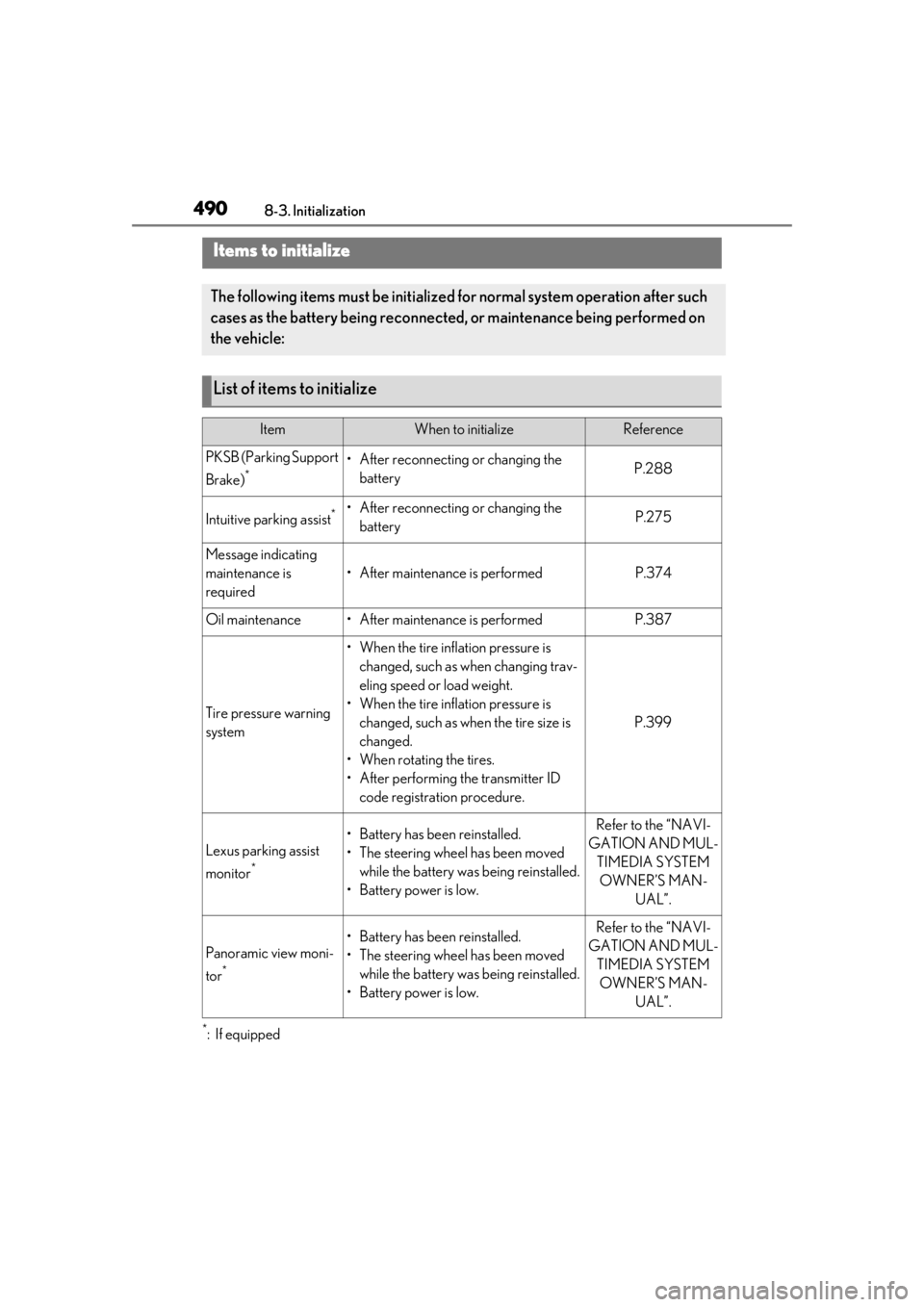
4908-3. Initialization
8-3.Initialization
*:If equipped
Items to initialize
The following items must be initialized for normal system operation after such
cases as the battery being reconnected, or maintenance being performed on
the vehicle:
List of items to initialize
ItemWhen to initializeReference
PKSB (Parking Support
Brake)
*• After reconnecting or changing the batteryP.288
Intuitive parking assist*• After reconnecting or changing the batteryP.275
Message indicating
maintenance is
required
• After maintenance is performedP.374
Oil maintenance• After maintenance is performedP.387
Tire pressure warning
system
• When the tire inflation pressure is changed, such as when changing trav-
eling speed or load weight.
• When the tire inflation pressure is changed, such as when the tire size is
changed.
• When rotating the tires.
• After performing the transmitter ID code registration procedure.
P.399
Lexus parking assist
monitor
*
• Battery has been reinstalled.
• The steering wheel has been moved while the battery was being reinstalled.
• Battery power is low.Refer to the “NAVI-
GATION AND MUL- TIMEDIA SYSTEM OWNER’S MAN- UAL”.
Panoramic view moni-
tor
*
• Battery has been reinstalled.
• The steering wheel has been moved while the battery was being reinstalled.
• Battery power is low.Refer to the “NAVI-
GATION AND MUL- TIMEDIA SYSTEM OWNER’S MAN- UAL”.
Page 510 of 520

510Alphabetical Index
If a warning light turns on ...................... 427
If a warning message is displayed..... 436
If the battery is discharged .................... 444
If the electronic key does not operate properly....................................................... 442
If the engine will not start ....................... 439
If the fuel filler door cannot be opened ........................................................................... 441
If the vehicle is trapped in rising water ...........................................................................419
If you have a flat tire ..................................438
If you lose your keys................................... 441
If you think something is wrong ......... 425
If your vehicle becomes stuck............. 452
If your vehicle has to be stopped in an
emergency ................................................. 418
If your vehicle needs to be towed ....... 421
If your vehicle overheats ........................ 449
Engine ACCESSORY mode ............................... 177
Compartment .............................................383
Engine compartment cover .................384
Engine cover................................................384
Engine switch................................................. 174
Fuel pump shut off system .................... 426
Hood................................................................. 381
How to start the engine............................ 174
Identification number ............................... 457
If the engine will not start ....................... 439
If your vehicle has to be stopped in an
emergency ................................................. 418
Ignition switch (engine switch) ............. 174
Overheating................................................. 449
Tachometer ............................................ 75, 78
Engine compartment cover .................... 384
Engine coolant Capacity .........................................................459
Checking ...................................................... 388
Preparing and checking before winter.........................................................................309
Engine coolant temperature gauge 75, 78
Engine cover ................................................. 384 Engine immobilizer system ........................ 64
Engine oil
Capacity ........................................................ 458
Checking ...................................................... 386
Preparing and checking before winter......................................................................... 309
Warning light ...............................................428
Engine oil maintenance data .................. 387
Engine switch .................................................. 174 Auto power off function............................ 177
Changing the engine switch modes .. 177
If your vehicle has to be stopped in an emergency .................................................. 418
EPS (Electric Power Steering) .............. 304 Warning light .............................................. 430
Event data recorder (E DR) ........................... 8
F
FCTA (Front Cross Traffic Alert) ......... 235
First-aid kit storage belt ............................350
Flat tire
Tire pressure warning system ............ 395
Floor mats ...........................................................22
Fluid Automatic transmission ......................... 460
Brake ................................................................. 461
Washer .......................................................... 390
Footwell light ................................................. 340
Front automatic air conditioning system .......................................................................... 323
Front Cross Traffic Alert (FCTA) ......... 235
Front passenger occupant classification system .............................................................. 40
Front seats Adjustment ....................................................... 121
Cleaning ...........................................................371
Correct driving posture ............................ 23
Driving position memory ........................ 133
Head restraints............................................. 138
Memory recall function............................ 135
Power easy access system .................... 133
Refresh system ..............................................126